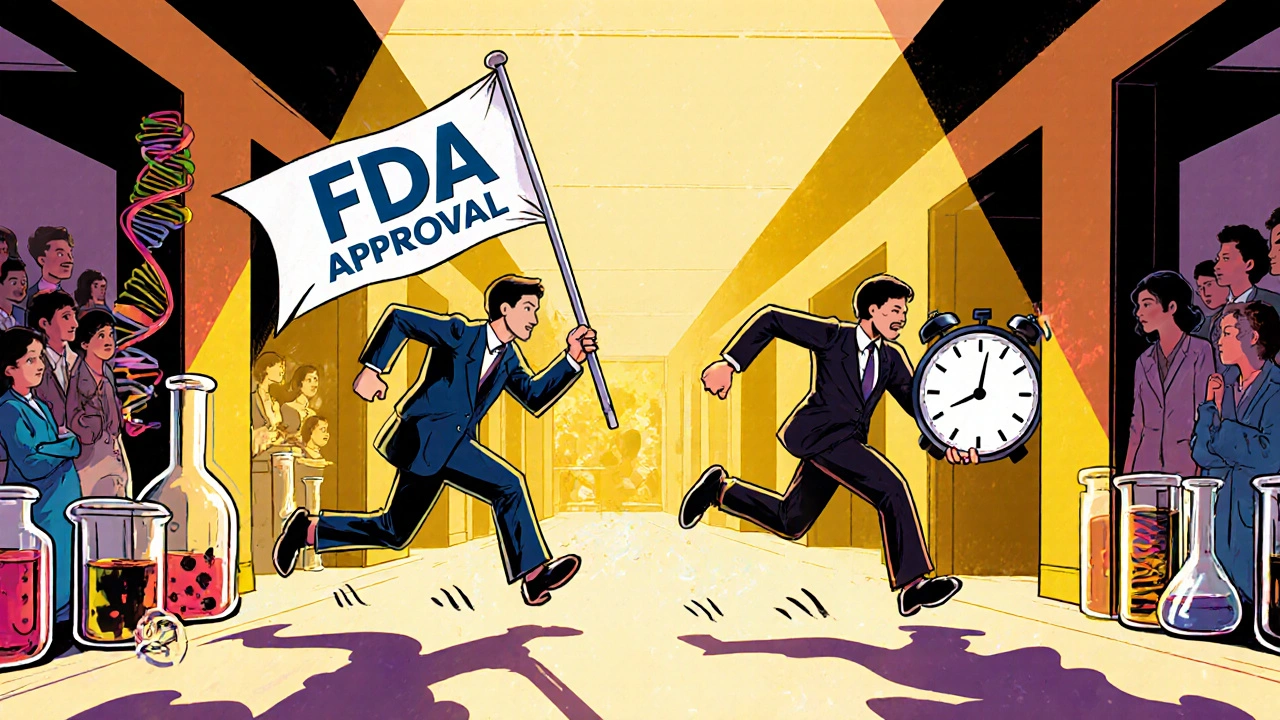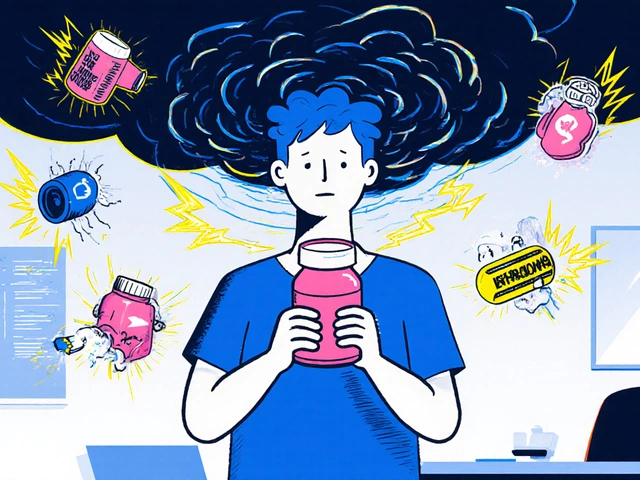Before 1983, fewer than 40 treatments existed for rare diseases in the U.S. Today, over 1,000 are approved. The shift didn’t happen because drug companies suddenly cared more about small patient groups. It happened because the government gave them a real reason to try: orphan drug exclusivity.
What orphan drug exclusivity actually means
Orphan drug exclusivity is a seven-year period of market protection granted by the FDA after a drug is approved to treat a rare disease. It doesn’t mean the drug is patented. It doesn’t mean no one else can make it. It means that for seven years, the FDA won’t approve another company’s version of that same drug for that same rare condition - unless the new version proves it’s clinically superior. The law behind this is the Orphan Drug Act of 1983. Before it passed, pharmaceutical companies had little incentive to spend hundreds of millions developing a drug for a disease affecting just a few thousand people. The market was too small to recover costs. The Orphan Drug Act changed that by guaranteeing a monopoly on sales for the first company to get approval. The exclusivity clock starts ticking on the day the FDA approves the drug for marketing - not when the patent is filed or when clinical trials begin. This is important. A drug can have a 20-year patent, but if the patent expires before FDA approval, orphan exclusivity still kicks in and protects the drug for seven years from approval date.How it works: the "first to market" rule
Here’s where it gets interesting. Multiple companies can apply for orphan designation on the same drug for the same disease. There’s no limit. But only one wins the exclusivity. It’s a race. If Company A gets FDA approval first for a drug treating Duchenne muscular dystrophy, Company B can’t get approval for the exact same drug for the same disease for seven years - even if Company B’s version is cheaper or better manufactured. Company B would have to prove their version offers a "substantial therapeutic improvement" - like better survival rates, fewer side effects, or a new way of delivering the drug. That bar is extremely high. Since 1983, only three cases have met it. This creates a powerful incentive to move fast. Companies rush through clinical trials, file for orphan designation as early as Phase 1, and work closely with the FDA to avoid delays. The FDA approves about 95% of properly submitted orphan designation requests, and the review takes roughly 90 days.It’s not a patent - and that’s the point
Many assume orphan exclusivity replaces patents. It doesn’t. In fact, for 88% of orphan drugs, patents are the main form of protection. Orphan exclusivity is a backup - and sometimes the only thing holding off generics. Patents protect the chemical structure or method of use. Orphan exclusivity protects the specific use for a rare disease. So if a drug is approved for both a rare disease and a common one, generics can enter the market for the common use while the original drug keeps its exclusivity for the rare one. Take amifampridine. It was originally approved for a common nerve condition. Later, it got orphan designation for Lambert-Eaton myasthenic syndrome (LEMS). Once approved for LEMS, the company got seven years of exclusivity for that use - even though the drug had been on the market for decades for other reasons. That’s the power of this system.
How it compares globally
The U.S. gives seven years. The European Union gives ten. And in Europe, companies can get an extra two years if they complete pediatric studies for the rare disease. The EU also has a loophole: if a drug is making more money than expected, the exclusivity can be cut from ten to six years. The U.S. doesn’t have that. The EU’s system is more flexible, but the U.S. system is simpler and faster. In the U.S., you don’t need to prove the drug is groundbreaking - just that the disease is rare and the drug works. That’s why more orphan drugs are approved in the U.S. than anywhere else.Who benefits - and who complains
Patient groups overwhelmingly support orphan exclusivity. A 2022 survey by the National Organization for Rare Disorders found 78% of advocacy groups consider it "essential" for getting new treatments developed. Without it, many rare diseases would have no treatments at all. But the system isn’t perfect. Critics point to cases where big pharmaceutical companies got orphan status for drugs already making billions in non-orphan markets. Humira, for example, received multiple orphan designations despite being one of the top-selling drugs in the world for arthritis and other conditions. That’s allowed under current rules - and it’s controversial. Generic drug makers argue this creates artificial monopolies. One executive wrote in an FDA public comment: "Why should a drug that already makes $20 billion a year get seven more years of exclusivity just because it’s also used by 5,000 people with a rare condition?"What’s changing in 2025
The number of orphan designations has exploded. In 2010, the FDA granted 127. In 2022, it granted 434. By 2027, Deloitte predicts 72% of all new drugs will have orphan status. The FDA is paying attention. In May 2023, it issued new draft guidance to clarify what counts as the "same drug" - especially when companies try to get multiple orphan designations for different uses of the same molecule. This is aimed at stopping "salami slicing" - the practice of breaking one drug into many tiny orphan indications to extend market protection. The European Commission is also reviewing its rules. A public consultation in late 2023 explored reducing the exclusivity period from ten to eight years for drugs that end up selling far more than expected. But here’s the bottom line: despite the criticism, orphan drug exclusivity still works. It’s the reason 500+ rare disease drugs exist today instead of 38. It’s the reason biotech startups can raise funding to develop treatments for diseases that affect fewer people than a small town.
What this means for patients and families
For families dealing with a rare disease, this system is a lifeline. A child with spinal muscular atrophy, for example, now has multiple treatment options - all made possible because companies knew they’d have a protected market to recoup their investment. But there’s a trade-off. The cost of these drugs is often extremely high. That’s because the company has to recover R&D costs from a tiny patient pool. A drug for a disease affecting 5,000 people might cost $500,000 per year per patient. That’s not because the drug is expensive to make. It’s because the market is so small. Patient advocates know this. That’s why 42% of them in the NORD survey expressed concern about pricing - even while supporting the exclusivity system. They’re not against incentives. They’re against unfair prices.How companies use this system strategically
Successful drug developers don’t wait until the end of clinical trials to think about exclusivity. They start planning in Phase 1. They hire regulatory consultants to map out the disease prevalence data. They submit orphan designation applications as soon as possible - sometimes before they even know if the drug will work. They also look for opportunities to expand the drug’s use. If a drug works for one rare disease, they test it for others. Each new indication is a new seven-year clock. That’s how a single molecule can become a portfolio of protected treatments. It’s not manipulation. It’s strategy. And it’s exactly what the Orphan Drug Act intended: to turn rare disease research from a loss into a viable business.Why this matters now
Orphan drugs now make up nearly a quarter of all global prescription drug sales. In 2022, they generated $217 billion. That’s more than the entire pharmaceutical market of Canada. The trend isn’t slowing. With advances in gene therapy, RNA treatments, and precision medicine, more rare diseases are becoming treatable. And each one needs a business model. Orphan drug exclusivity is that model. It’s not perfect. It’s not fair in every case. But it’s the reason children with previously untreatable conditions are now walking, talking, and living longer. And for now, that’s what matters most.How long does orphan drug exclusivity last in the U.S.?
In the United States, orphan drug exclusivity lasts for seven years, starting from the date the FDA approves the drug’s marketing application. This protection applies only to the specific drug for the specific rare disease indication it was approved for.
Can a drug have both a patent and orphan exclusivity?
Yes, most orphan drugs have both. Patents protect the chemical structure or method of use, while orphan exclusivity protects the use for a specific rare disease. Even if a patent expires, orphan exclusivity can still block competitors for up to seven years after approval.
What does "clinically superior" mean in orphan drug approvals?
"Clinically superior" means the new drug must show a significant improvement over the existing one - such as better survival rates, fewer side effects, or a new delivery method that improves patient outcomes. This standard is very high. Since 1983, only three cases have met it, making it extremely rare for a competitor to enter the market during the exclusivity period.
Can generics be approved for the same drug if it’s used for a different condition?
Yes. Orphan exclusivity only applies to the approved rare disease indication. If a drug is approved for both a rare disease and a common one, generics can be approved for the common use. For example, a drug with orphan status for a rare neurological condition can still face generic competition for treating a more common form of the same condition.
Why do some people say orphan exclusivity is being misused?
Critics argue that some companies get orphan status for drugs already making billions in non-orphan markets - like Humira - and then use exclusivity to extend their monopoly. This practice, sometimes called "salami slicing," involves splitting one drug into multiple rare disease uses to lock in extra years of protection. The FDA is now reviewing this trend with new guidance.





Cynthia Boen
This system is a joke. Companies are gaming it to extend monopolies on drugs that already make billions. Humira getting orphan status? Come on. We're paying $500k/year for a drug that should be generic. This isn't innovation - it's corporate greed dressed up as charity.
Amanda Meyer
While the pricing concerns are valid, we can't ignore the fact that without this law, there would be virtually no treatments for conditions like SMA or Duchenne. The incentive structure works - it’s just poorly calibrated. We need targeted reforms, not blanket condemnation. Maybe cap exclusivity for drugs with global revenues over $10B? That’s a compromise worth exploring.
vikas kumar
From India, I see this differently. We don’t have this system, and our patients suffer because of it. But I also see how big pharma exploits loopholes. Maybe the answer isn’t to kill the system - but to make it global. If every country offered similar incentives, maybe prices would drop because competition would rise across borders.
Vanessa Carpenter
I have a friend whose kid got a life-saving drug thanks to this law. I don’t care if the company made a profit. I care that my friend’s child is alive. The system is broken? Sure. But it’s broken in a way that still saves lives. Let’s fix the pricing, not the incentive.
Bea Rose
7 years. Not 20. Not 30. 7. That’s it. No more, no less. The math is simple: if you can’t make a return in 7 years on a rare disease drug, you shouldn’t be in this business.
Michael Collier
It is imperative to recognize that the Orphan Drug Act of 1983 represents a paradigmatic shift in public health policy, wherein market-based incentives were deliberately aligned with humanitarian objectives. The statistical proliferation of approved therapies - from 40 to over 1,000 - constitutes an unequivocal triumph of regulatory innovation. To undermine this framework without a robust, evidence-based alternative is to jeopardize the very foundation of future therapeutic development for underserved populations.
Shannon Amos
So let me get this straight - we reward companies for taking a drug that already makes $20B a year and giving it a new label for 5,000 people… and we call that ‘innovation’? Next they’ll patent oxygen.
stephen riyo
Wait, so if a drug works for arthritis and also for some rare nerve thing… and the arthritis use is generic… but the rare thing is still protected… then patients with the rare thing pay $500k/year… but people with arthritis pay $50? That’s… that’s insane. Like, literally insane. Who thought this was a good idea? I mean… really?
Jaspreet Kaur
The real question isn't whether the system works - it does, undeniably - but whether we are measuring success by the number of drugs approved or by the number of lives improved. We have created a machine that turns suffering into profit. And while profit is necessary to fuel innovation, it must not become the only language we speak when talking about human lives. Maybe the next step isn't more regulation - but more humility.